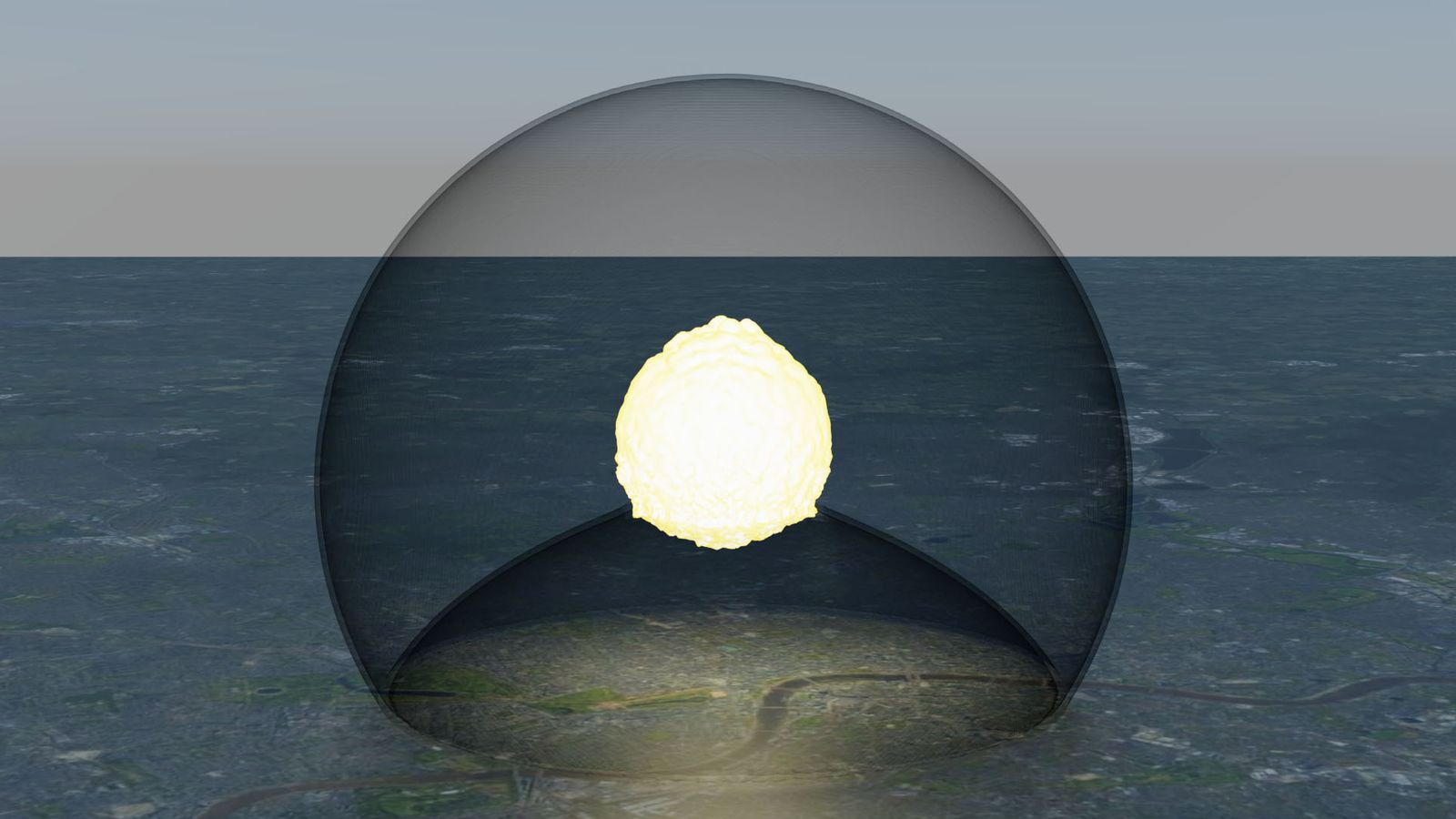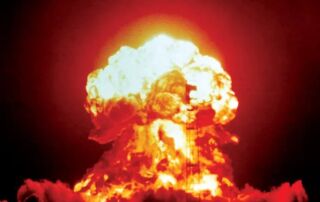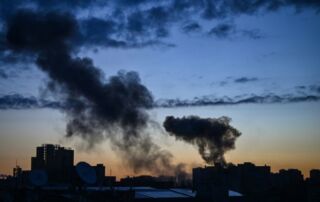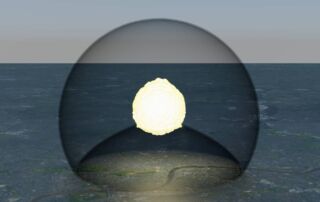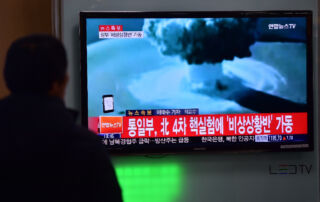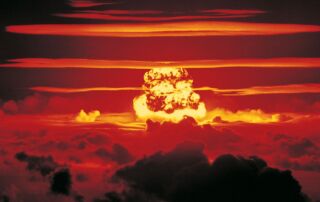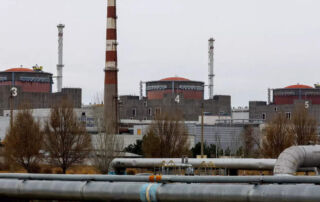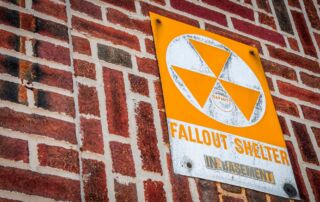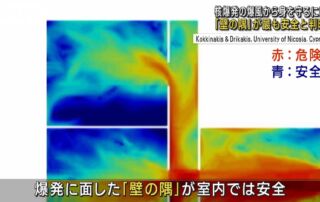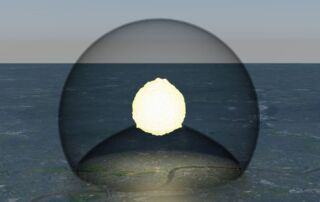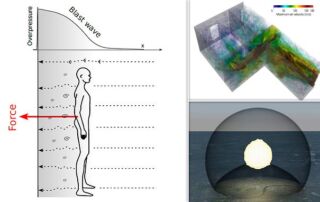Nuclear explosion impact on humans indoors
Ioannis W. Kokkinakis and Dimitris Drikakis
University of Nicosia
This study investigates the nuclear blast effects on humans inside a building within a moderate damage zone. These effects depend on many parameters that must be better understood. In addition, the nuclear blast effects will spread further away than the devastating destruction zone, where most people are killed instantly. However, these injuries will vary depending on a person’s position in the building and the air velocities attained when the blast wave enters indoors. The blast wave effects are examined for an indicative, easily reproducible indoor arrangement.
Objectives of the study
What Does This Mean?
- In the moderate damage zone, the blast wave is enough to topple some buildings and injure people caught outdoors. However, sturdier buildings, such as concrete structures, can remain standing.
- Injuries will vary depending on a person’s position in the building and the air velocities attained when the blast wave enters indoors.
- The force applied to a standing person from the speed of the gusts formed at several locations in the interior is equivalent to several g-forces of body mass acceleration capable of lifting and throwing any person off the ground.
- There are preferential areas in the rooms where a human can avoid the risk of exposure to the highest wind forces.
Nuclear explosion impact on humans indoors
Read the full paperNon-Technical Summary
The paper entitled ‘Nuclear explosion impact on humans indoors’ is based on the simulation of an atomic bomb explosion from a typical intercontinental ballistic missile and the resulting blast wave, which shows how it would affect people sheltering indoors.
The team used advanced computer modeling to study how a nuclear blast wave speeds through a standing structure. Their simulated structure featured rooms, windows, doorways, and corridors and allowed them to calculate the speed of the air following the blast wave and determine the best and worst places to be.
The study concludes that in the moderate damage zone, the blast wave is enough to topple some buildings and injure people caught outdoors. However, sturdier buildings, such as concrete structures, can remain standing.
According to their results, simply being in a sturdy building is not enough to avoid risk. The tight spaces can increase airspeed, and the involvement of the blast wave causes air to reflect off walls and bend around corners. In the worst cases, this can produce a force equivalent to 18 times a human’s body weight.
The authors stress that the time between the explosion and the arrival of the blast wave is only a few seconds, so quickly getting to a safe place is critical.
Contact Information
For more information about this study, please contact Prof Dimitris Drikakis at [email protected].
For more information about this study, please contact Dr Ioannis William Kokkinakis at [email protected].
Press Coverage
Articles and press mentions in global media about the research.
What really happens during a nuclear attack? – The Jerusalem Post
The Islamic Republic of Iran has threatened to “raze Tel Aviv and Haifa to the ground” in an unprecedented nuclear attack, as nonproliferation experts warn that the country now has enough enriched uranium for at least one nuclear bomb.
Here’s How To Survive A Nuclear Explosion, According To Scientists
According to a study led by Dimitris Drikakis, a fluid dynamics researcher at the University of Nicosia in Cyprus, a "moderate damage zone" just a few miles from the epicenter could possibly raise the chance of survival.
UNIC-authored paper on how to shelter from nuclear explosions attracts worldwide attention | in-cyprus.com
A new research paper by University of Nicosia (UNIC) researchers Dr Ioannis Kokkinakis and Professor Dimitris Drikakis, has attracted worldwide attention by offering insight into how people can shelter in the case of a nuclear explosion.
Fluid Dynamic Researchers Put Forth New Findings on Survival in the Midst of a Nuclear Explosion | Tech Times
University of Nicosia researchers Dimitris Drikakis and Ioannis Kokinakis have released a comprehensive paper on understanding nuclear explosions.
You Might Survive a Nuclear Blast—if You Have the Right Shelter | WIRED
But let’s be honest: Most people, even in the moderate damage zone, won’t survive. Hardly anyone lives or works in nearly windowless reinforced-concrete buildings, nor in the vicinity of a concrete bunker.
Nuclear Explosions: Scientists reveal best places to take shelter during nuclear explosions; Know here – The Economic Times
The Cypriot team investigated how a nuclear bomb wave travels through a standing building using modern modelling tools.
How to survive a nuclear bomb shockwave | Popular Science
Very little is known about what is happening when you are inside a concrete building that has not collapsed,” says Dimitris Drikakis, an engineer at the University of Nicosia and co-author of the new paper.
核爆発の爆風から身を守る屋内最適な場所とは シミュレーションで判明
核爆発による爆風から屋内で身を守ることができる最も安全な場所が、シミュレーションによって判明したとヨーロッパの研究者が発表しました。 キプロスにあるニコシア大学の研究者は、750キロトンの破壊力を持つ核弾頭が爆発したと想定して、コンクリート製の建物が爆風に耐えられる爆心地からやや離れた地域で室内の人間にどんな影響があるかを調べました。 シミュレーションでは、爆風は室内に侵入すると風速が増し、爆発に面した窓や扉の近く、通路が狭くなる廊下では最大風速が184メートルを超えて体が吹き飛ばされる可能性があることが分かりました。 一方で、爆発に面した「壁の隅」が比較的爆風の被害を避けることができる室内では最も安全な場所だということです。 Source: 核爆発の爆風から身を守る屋内最適な場所とは シミュレーションで判明
Scientists simulated a nuclear explosion on a major city – and how you might hope to survive it | Science & Tech News | Sky News
Scientists have simulated what would happen if a nuclear bomb was dropped on a major city.
How to survive a nuclear explosion: Scientists reveal the safest places to take shelter | Daily Mail Online
How to survive a nuclear explosion: Scientists reveal the safest places to take shelter | Daily Mail Online Since Russia's invasion on Ukraine started almost a year ago, the threat of devastating nuclear war has for many felt closer than ever before. Now, a study reveals the best way to survive a powerful nuclear explosion if you're inside a concrete building – as long as it hasn't been toppled by the blast. According to the researchers, the best place [...]
